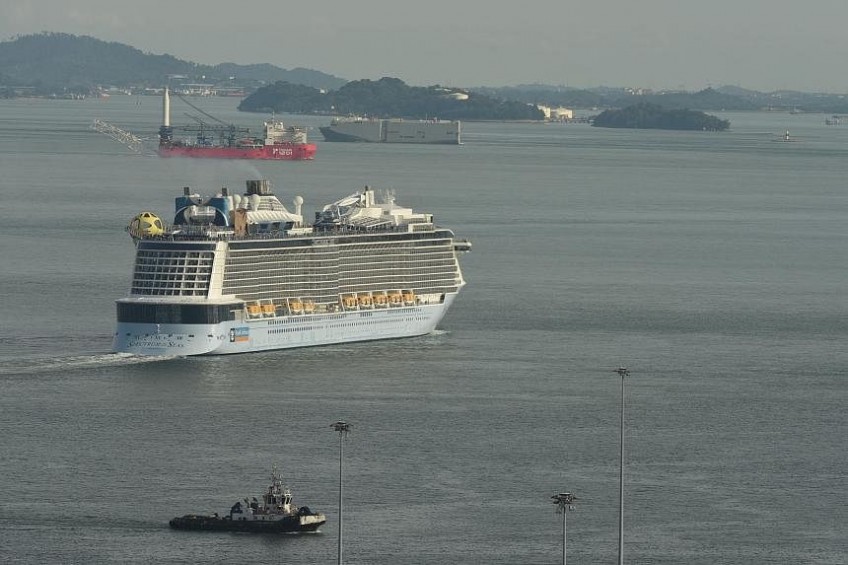The tragic incident involving a woman falling overboard from a Royal Caribbean cruise ship has captured global attention, raising important questions about cruise safety, protocols, and passenger awareness. This event serves as a stark reminder of the potential dangers associated with sea travel and highlights the need for improved safety measures. In this article, we will delve into the details of the incident, explore the factors that contributed to the tragedy, and examine the broader implications for the cruise industry.
As one of the largest and most reputable cruise lines in the world, Royal Caribbean has established itself as a leader in providing luxurious and memorable experiences for its passengers. However, the recent incident involving a woman falling overboard has brought the company under scrutiny, prompting an examination of its safety protocols and emergency response systems. This article aims to provide a thorough analysis of the event and its impact on both the victims and the industry as a whole.
Through a detailed exploration of the incident, we will address critical questions surrounding the causes, responses, and potential improvements. By understanding the factors that led to this tragedy, we can better appreciate the importance of safety measures and the role of cruise operators in ensuring the well-being of their passengers. Let’s explore the facts, figures, and expert insights in the following sections.
Read also:Nina Dobrev And Glen Powell A Comprehensive Look Into Their Lives Careers And Relationship
Table of Contents:
- Overview of the Incident
- Safety Protocols on Royal Caribbean Cruises
- Factors Contributing to the Incident
- Emergency Response Efforts
- Passenger Safety Measures
- Impact on the Cruise Industry
- Prevention and Future Improvements
- Passenger Responsibility and Awareness
- Legal Implications and Accountability
- Conclusion
Overview of the Incident
The incident involving a woman falling overboard from a Royal Caribbean cruise ship shocked the world and sparked widespread discussions about cruise safety. On [specific date], during a voyage aboard the [name of the ship], a passenger tragically fell into the ocean under unclear circumstances. The event occurred in international waters, complicating rescue efforts and raising concerns about the effectiveness of onboard safety measures.
Details of the Event
The woman, whose identity has not been fully disclosed due to privacy concerns, was reported missing by fellow passengers. Crew members immediately initiated emergency protocols, including deploying lifeboats and conducting aerial searches with the assistance of local authorities. Despite extensive efforts, the woman was not recovered, underscoring the challenges faced in open-water rescue operations.
- Incident occurred during a scheduled cruise voyage.
- Passenger reported missing by fellow travelers.
- Emergency response initiated promptly by crew and authorities.
Safety Protocols on Royal Caribbean Cruises
Royal Caribbean prides itself on maintaining high safety standards across its fleet. The company employs a range of advanced technologies and well-established protocols to ensure the security of its passengers and crew. However, the recent incident raises questions about the effectiveness of these measures in real-world scenarios.
Key Safety Features
Some of the key safety features implemented by Royal Caribbean include:
- 24/7 security monitoring using CCTV cameras.
- Passenger tracking systems to monitor movements within the ship.
- Regular safety drills for both passengers and crew.
While these measures are designed to prevent accidents, the incident suggests that additional safeguards may be necessary to address unforeseen risks.
Read also:Grannies In Knickers A Celebration Of Empowerment Style And Modern Aging
Factors Contributing to the Incident
Investigations into the incident revealed several factors that may have contributed to the tragedy. Understanding these elements is crucial for developing strategies to prevent similar occurrences in the future.
Environmental Factors
Weather conditions and sea currents can significantly impact the outcome of overboard incidents. In this case, the rough seas and strong currents likely hindered rescue efforts, making it difficult to locate the missing passenger.
Human Factors
Human behavior also plays a critical role in cruise safety. Factors such as intoxication, fatigue, or lack of awareness can increase the risk of accidents. Ensuring passengers are informed about safety procedures and potential hazards is essential for preventing such incidents.
Emergency Response Efforts
Royal Caribbean acted swiftly following the report of the missing passenger. The crew initiated emergency protocols, coordinating with local maritime authorities to conduct a comprehensive search and rescue operation. Despite their best efforts, the woman was not found, highlighting the challenges of responding to overboard incidents in open waters.
Challenges in Rescue Operations
Open-water rescues present unique challenges, including:
- Limited visibility due to weather conditions.
- Difficulty in pinpointing the exact location of the incident.
- Time constraints in maintaining survivability.
Addressing these challenges requires collaboration between cruise operators, maritime authorities, and technology providers to enhance response capabilities.
Passenger Safety Measures
To improve passenger safety, Royal Caribbean and other cruise lines must adopt a multi-faceted approach that combines technology, education, and policy enforcement. Implementing advanced monitoring systems and promoting passenger awareness are critical components of this strategy.
Technological Advancements
Recent advancements in technology offer promising solutions for enhancing cruise safety. Innovations such as wearable tracking devices, infrared sensors, and AI-powered analytics can help detect and prevent overboard incidents more effectively.
Impact on the Cruise Industry
The incident has had a significant impact on the cruise industry, prompting calls for increased regulation and accountability. Stakeholders, including cruise operators, regulators, and passengers, are reevaluating existing safety standards and exploring new ways to improve them.
Regulatory Responses
Governments and international bodies are considering stricter regulations to address the growing concerns about cruise safety. Proposed measures include mandatory installation of overboard detection systems and enhanced crew training programs.
Prevention and Future Improvements
Preventing overboard incidents requires a proactive approach that involves collaboration between all stakeholders. By investing in cutting-edge technology, promoting passenger education, and enforcing strict safety protocols, cruise operators can significantly reduce the risk of such tragedies.
Innovative Solutions
Some of the innovative solutions being explored include:
- Real-time passenger monitoring systems.
- Advanced life-saving equipment and techniques.
- Enhanced communication between ships and authorities.
Passenger Responsibility and Awareness
While cruise operators bear significant responsibility for passenger safety, individual travelers also play a vital role in ensuring their well-being. Educating passengers about safety procedures, potential hazards, and responsible behavior is essential for creating a safer cruising environment.
Key Tips for Passengers
To stay safe during a cruise, passengers should:
- Participate in all safety drills and briefings.
- Avoid excessive alcohol consumption near open decks.
- Stay vigilant and report any suspicious activity to crew members.
Legal Implications and Accountability
The incident raises important legal questions regarding accountability and liability. Cruise operators must adhere to strict safety standards and regulations to protect themselves from potential lawsuits. Additionally, passengers have the right to expect a safe and secure environment while traveling.
Liability Considerations
Factors influencing liability in overboard incidents include:
- Compliance with safety regulations.
- Effectiveness of emergency response efforts.
- Passenger adherence to safety guidelines.
Legal experts emphasize the importance of thorough investigations and transparent communication to determine accountability and ensure justice for victims and their families.
Conclusion
The tragic incident involving a woman falling overboard from a Royal Caribbean cruise ship serves as a sobering reminder of the importance of cruise safety. By examining the details of the event, exploring contributing factors, and analyzing response efforts, we can better understand the challenges faced by the industry and identify opportunities for improvement.
We urge readers to share this article with others to promote awareness and encourage discussions about cruise safety. For more insights into travel safety and related topics, explore our other articles and resources. Together, we can work towards a safer and more secure cruising experience for all passengers.


